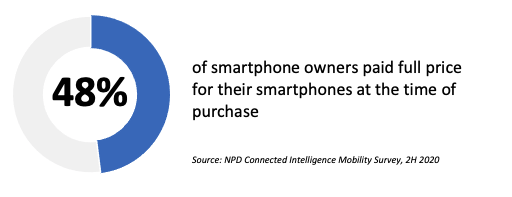
AT&T extends EIP payments to 36 months
AT&T has modified its Equipment Installment Program (EIP), which now offers customers 36-month interest-free financing for their phone and tablet purchases. The carrier’s previous program offered customers the ability to pay in 30 monthly installments compared to rival T-Mobile’s EIP of 24 months. Verizon, on the other hand, has been offering customers a 30-month EIP on flagship phones and tablets from Apple and Samsung (the LG Wing and Motorola’s Razr and Edge+ are the only exceptions). Regional postpaid carrier USCellular is the only carrier that has been offering a 36-month EIP. It’s noteworthy that AT&T’s extension of its EIP has also impacted the carrier’s popular trade-in promotions program. Customers (new and existing) who trade in an old smartphone can currently get up to $700 in service credits, which are deducted from their wireless bills each month. With the new 36-month program, customers will need to be on “contract” with the carrier until the 36th month to receive their full trade-in credit.
The NPD Take:
- AT&T's aggressive promotional push, extending its upgrade promotions to its existing user base (versus just the newcomers), has already helped the carrier significantly in suppressing churn, and the new 36-month program with the link to trade-in credits will further improve churn.
- The 36-month financing option lowers the monthly payments, thus gives AT&T a new marketing weapon alongside its aggressive upgrade promotions, which are offered to all customers. However, all this aggressiveness comes at a cost; AT&T’s operating expenses have substantially increased since the beginning of the new upgrade promo scheme in early Q4 2020, and the extra six-month financing will put further pressure on the bottom line.
Mediatek gains ground with low-end phone debuts
Dish’s Boost Mobile and AT&T’s prepaid arm Cricket Wireless launched new low-end devices, which are powered by Qualcomm’s rival Mediatek. Boost Mobile picked up Wiko’s Ride 3, a 6.1-inch display smartphone boasting Mediatek’s octa-core Helio A22 processor. Cricket, on the other hand, launched the new Cricket Ovation 2, a white-label 6.9-inch display smartphone built by Foxconn for Element, AT&T’s white-label ODM partner. The Ovation 2, like the Wiko Ride 3, runs on the Helio A22 processor but is priced higher ($129) due to its large display. The Wiko Ride3, on the other hand, carries a $99 price tag but is offered for $35 for new and existing customers.
The NPD Take:
- Mediatek is the default silicon choice for most of the sub-$150 Android smartphones due to industry leader Qualcomm’s relatively higher chipset costs. However, the Chinese chipset manufacturer is gradually extending into the mid-tier market and joining forces with leading brands such as Samsung. T-Mobile’s top promotional phone, Samsung’s Galaxy A32 5G, runs on Mediatek’s latest Dimension chipset platform and has been one of the most popular phones sold in the US market in Q2 2021.
- Supply shortages for chipsets and other micro components are gradually boosting the BOM costs (and therefore sell-in costs) of Android smartphones. Smaller OEMs/ODMs with limited scalability are having difficult times meeting carriers’ price objectives. For instance, the Vietnamese ODM Vinsmart, which had previously been one of AT&T's white-label partners, has recently announced that it is exiting the smartphone production business. These supply-driven pricing pressures will eventually force carriers (as in the case with Boost Mobile) to boost their subsidy levels to keep MSRPs at similar levels as in previous years.